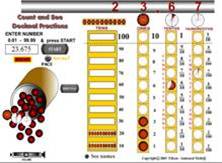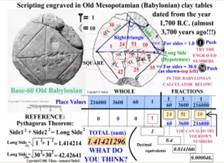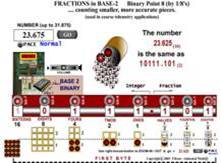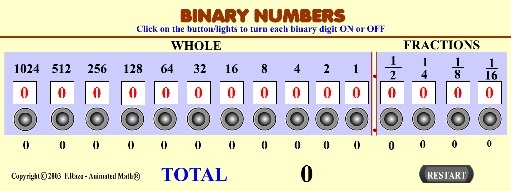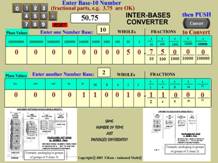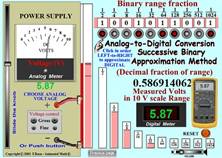REPRESENTING FRACTIONS
Call the Representing Pieces of One Whole display.
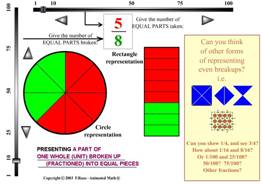 This display features the visual representation of fractions, as a collection of a number of equal parts of a whole unit (“EVEN BREAKUPS”). Both the total number of equal parts of the whole, as well as the selected partial number of them, are set by using corresponding slider bars. The selected fractions are shown in both a circle and rectangle forms, and an image is included to remind the students of even breakups can be made of any “unit” so desired.
This display features the visual representation of fractions, as a collection of a number of equal parts of a whole unit (“EVEN BREAKUPS”). Both the total number of equal parts of the whole, as well as the selected partial number of them, are set by using corresponding slider bars. The selected fractions are shown in both a circle and rectangle forms, and an image is included to remind the students of even breakups can be made of any “unit” so desired.
HANDS ON: Wide-screen/Wireless-mouse or Touch-Screen
1.- Describe the parts of the display, including the CIRCLE and RECTANGLE representations of fractions, the DENOMINATOR and NUMERATOR numbers, and their control slider bars.
2.- Ask one student each to use the slider bars to represent the following fractions using the display, and then draw the resulting image on a piece of paper (formatted pages can be obtined and printed from: www://animath.net/drawfracts1.pdf):
| |
Circle |
Rectangle |
1/2 |
DRAW |
DRAW |
1/3 |
DRAW |
DRAW |
1/4 |
DRAW |
DRAW |
1/5 |
DRAW |
DRAW |
1/100 |
DRAW |
DRAW |
2/3 |
DRAW |
DRAW |
3/4 |
DRAW |
DRAW |
5/16 |
DRAW |
DRAW |
25/100 |
DRAW |
DRAW |
75/100 |
DRAW |
DRAW |
* The same fraction examples of this activity can be used for the purpose of developing mastery in visualizing fractions, by attempting to obtain each their representation on their screen (e.g. computer lab) in the shortest time possible, using the "timer" located in the blue section at the bottom of the display.
When the yellow button in this section is first pressed, the timer will be set in a READY mode, waiting for the actions to represent the fraction desired. The counter will then begin to move as soon as any of the controls of the display are touched to begin the representation attempt.
The timer will keep counting elapsed time (seconds) during the attempt, and will stop only when the yellow button is pressed again, to signal the attempy "finished". The count will then freeze and can then be recorded. The counts of different students can also be compared to determine "the fastest" attempt in a group.
The yellow button will then need to be pressed again, to make the timer reset and ready for a new attempt or case.
COMPARING FRACTIONS
Call the EQUIVALENT REPRESENTATIONS display.
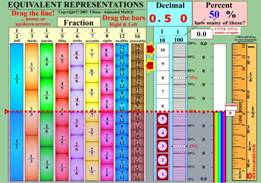 This display allows side-by-side visual comparison of common fractions in rectangular, strip-tile form. The strips can be slid horizontally, and placed near other fractions of interest for comparison. A dotted red-line-and-shade slide cover is also included, providing an up-down shade to highlight comparisons and equivalences. The images of a foot, and an inch, and a “batch of apples” strip are also available to allow the visualization and comparison of their fractioning.
This display allows side-by-side visual comparison of common fractions in rectangular, strip-tile form. The strips can be slid horizontally, and placed near other fractions of interest for comparison. A dotted red-line-and-shade slide cover is also included, providing an up-down shade to highlight comparisons and equivalences. The images of a foot, and an inch, and a “batch of apples” strip are also available to allow the visualization and comparison of their fractioning.
For each fraction type, the name of the fraction is stated at the top, e.g. “half”, “thirds”, “fourths”, etc. The digital-numeric representation of the pieces in each strip is shown on each piece, e.g. “1/2” (one-half) “1/3” (one-third) , “1/4” (one-fourth) , etc.
The fractions included are halves (1/2, blue), thirds (1/3, orange), fourths (1/4, green), fifths (1/5, red), sixths (1/6, purple), sevenths (1/7, yellow), eights (1/8, pink), tenths (1/10, white), twelfths (1/12, dark blue), sixteenths (1/16, brown), hundredths (1/100, white).
HANDS ON: Wide-screen/Wireless-mouse or Touch-Screen
1.- Describe the parts of the display, including the sliding fraction strips, the one-foot ruler, the one-inch, and the batch-of-apples strips. Show how the dotted-line-shade slides up and down to assist comparisons and equivalences across.
2.- Ask one student each to do the following, using the dotted-line-shade of the display:
a) Make sure the dotted line/shade in on the one half (1/2) mark. Which of the other fraction pieces shown are equivalent to (the same as) one half?
- _____ 2) _____ 3) _____ 4) ______ 5) ______ 6) _______ 7) _______
( 2/4, 3/6, 4/8, 6/12, 8/16, 5/10, 50/100 )
b) Mark one quarter (1/4). Which of the other fractions pieces shown are visually (close) equivalent to one quarter?
1) ______ 2) ______ 3) ______ 4) ________ ( 2/8, 3/12, 4/16, 25/100 )
c) Mark two thirds (2/3). Which of the other fraction pieces shown are visually (close) equivalent to two thirds?
1) ______ 2) ______ ( 4/6, 8/12, ~ 66/100)
d) Mark three quarters (3/4). Which of the other fraction pieces shown are visualy (close) equivalent to three quarters?
1) ______ 2) ______ 3) ______ 4) ________ ( 6/8, 9/12, 12/16, 75/100 )
e) Mark seven eighths (7/8). Which of the other fraction pieces shown are visually (close) equivalent to seven eights?
1) ______ 2) ________ ( 14/16, ~ 87/100)
DECIMAL AND PERCENT REPRESENTATIONS
3.- Focus on the two strips in the “Decimal” (turquoise) box, to the right of the 1/16 fraction strip. These columns are the first and only two breakdowns used in the decimal (Base-10) number system. This is because this system considers only breakdowns whose number of parts are multiples of the number 10. The decimal breakdowns are therefore tenths (1/10), hundredths (1/100), thousandths (1/1000), .... millionth (1/1000000) etc. Of particular interest is the 1/100 representation of fractions, which is widely used in daily life and referred to as “percents” of quantities.
4.- Ask one student each to use the red-dotted line across the strips, by clicking-and-dragging it, to show:
a) One half (1/2). What are the decimal and percent equivalents to one half? ( 0.5, 50% )
b) One quarter (1/4). What are the decimal and percent equivalents to one quarter? ( 0.25, 25% )
c) Two thirds (2/3). What are the decimal and percent equivalents to two thirds? ( 0.66.., 66.66..% )
d) Three quarters (3/4). What are the decimal and percent equivalents to three quarters? ( 0.75, 75% )
e) Seven eights (7/8) . What are the decimal and percent equivalents to seven eights? ( 0.875, 87.5% )
5.- Describe how the rainbow-colored column on the right side of the display can be used to show a number of items (apples), and a fraction of them. For example, if you enter 12 units at the top of the rainbow colored column, 12 units (total apples) will show to fill the column, but only 6 of them will be within a half (1/2) of the total.
6.- Ask one student each to use the display to answer the following questions:
a) How many of 24 units are in one half (1/2, 0.50, or 50%) of the total? ______ ( 12 )
b) How many of 24 units are in one quarter (1/4, 0.25, or 25%) of the total? ______ ( 6 )
c) How many of 24 units are in two-thirds (2/3, 0.66…., or 66.6….%) of the total? ______ ( 16 )
d) How many of 24 units are in three-quarters (3/4, 0.75, or 75%) of the total? ______ ( 18 )
e) How many of 24 units are in ten-twelfths (10/12, 0.838…., or 83.3….%) of the total? ______ ( 20 )
7.- Ask the class to focus on the yellow one-foot ruler at the extreme right of the display is available to show the number inches and/or parts of an inch contained in fractions of it. The whole foot, as we know, has 12 inches.
8.- Ask one student each to answer the following questions:
a) How many inches are in one half (1/2, 0.50, or 50%) of a foot? ______ ( 6 )
b) How many inches are in one quarter (1/4, 0.25, or 25%) of a foot? ______ ( 3 )
b) How many inches are in two-thirds (2/3, 0.66…., or 66.6….%) of a foot? ______ ( 8 )
b) How many inches are in three-quarters (3/4, 0.75, or 75%) of a foot? ______ ( 9 )
b) How many inches, or parts of an inch are in one-sixteenth (1/16, 0.0625, or 6.25%) of a foot? ______ ( ¾ or 0.75 )
EXPANSION ACTIVITIES
The following activities are intended to provide connections between the concepts of place value and fractions in different base systems, from ancient times, and into the future.
 This display features the visual representation of fractions, as a collection of a number of equal parts of a whole unit (“EVEN BREAKUPS”). Both the total number of equal parts of the whole, as well as the selected partial number of them, are set by using corresponding slider bars. The selected fractions are shown in both a circle and rectangle forms, and an image is included to remind the students of even breakups can be made of any “unit” so desired.
This display features the visual representation of fractions, as a collection of a number of equal parts of a whole unit (“EVEN BREAKUPS”). Both the total number of equal parts of the whole, as well as the selected partial number of them, are set by using corresponding slider bars. The selected fractions are shown in both a circle and rectangle forms, and an image is included to remind the students of even breakups can be made of any “unit” so desired. This display allows side-by-side visual comparison of common fractions in rectangular, strip-tile form. The strips can be slid horizontally, and placed near other fractions of interest for comparison. A dotted red-line-and-shade slide cover is also included, providing an up-down shade to highlight comparisons and equivalences. The images of a foot, and an inch, and a “batch of apples” strip are also available to allow the visualization and comparison of their fractioning.
This display allows side-by-side visual comparison of common fractions in rectangular, strip-tile form. The strips can be slid horizontally, and placed near other fractions of interest for comparison. A dotted red-line-and-shade slide cover is also included, providing an up-down shade to highlight comparisons and equivalences. The images of a foot, and an inch, and a “batch of apples” strip are also available to allow the visualization and comparison of their fractioning.